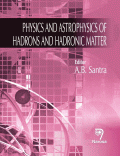About the book This volume contains well written articles in the field of hadron physics and hadronic matter pertaining to neutron stars. In the recent years, an effective field theory called Nuclear Effective Field Theory has been constructed from Quantum Chromodynamics, the fundamental theory of strong interaction, to provide a systematic approach to hardon physics and few-nucleon systems. Neutron stars are unique in the universe, providing an opportunity to study different phases of extremely dense hadronic matter. The subject of neutron stars has developed into a strongly interdisciplinary field connecting nuclear physics, particle physics and astrophysics. The articles in this volume discuss recent developments in both of the above topics starting with a pedagogical introduction. This book will be useful to graduate students, as well as researchers and teachers in the field of nuclear physics, particle physics and astrophysics. |



